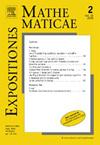由一维动力学引起的巴拿赫空间仿射等距的一些例子
IF 0.9
4区 数学
Q2 MATHEMATICS
引用次数: 0
摘要
我们提供了大量的Banach空间C0(S1), L1(S1)和L2(S1×S1)的仿射等距的例子,尽管它们是循环的(特别是,它们具有零漂移),但它们是不定点的。这些来自于圆微分同态群上的自然环,即对数、仿射和(Schwarzian导数的一种变化)。非常有趣的是,它们起源于在适当的上下文中具有普遍性的微分同构。我们还展示了如何推广这些例子,以获得满足相同性质的交换等距族。本文章由计算机程序翻译,如有差异,请以英文原文为准。
Some examples of affine isometries of Banach spaces arising from 1-D dynamics
We provide a large family of examples of affine isometries of the Banach spaces , and that are fixed-point-free despite being recurrent (in particular, they have zero drift). These come from natural cocycles on the group of circle diffeomorphisms, namely the logarithmic, affine and (a variation of the) Schwarzian derivative. Quite interestingly, they arise from diffeomorphisms that are generic in an appropriate context. We also show how to promote these examples in order to obtain families of commuting isometries satisfying the same properties.
求助全文
通过发布文献求助,成功后即可免费获取论文全文。
去求助
来源期刊
CiteScore
1.30
自引率
0.00%
发文量
41
审稿时长
40 days
期刊介绍:
Our aim is to publish papers of interest to a wide mathematical audience. Our main interest is in expository articles that make high-level research results more widely accessible. In general, material submitted should be at least at the graduate level.Main articles must be written in such a way that a graduate-level research student interested in the topic of the paper can read them profitably. When the topic is quite specialized, or the main focus is a narrow research result, the paper is probably not appropriate for this journal. Most original research articles are not suitable for this journal, unless they have particularly broad appeal.Mathematical notes can be more focused than main articles. These should not simply be short research articles, but should address a mathematical question with reasonably broad appeal. Elementary solutions of elementary problems are typically not appropriate. Neither are overly technical papers, which should best be submitted to a specialized research journal.Clarity of exposition, accuracy of details and the relevance and interest of the subject matter will be the decisive factors in our acceptance of an article for publication. Submitted papers are subject to a quick overview before entering into a more detailed review process. All published papers have been refereed.

 求助内容:
求助内容: 应助结果提醒方式:
应助结果提醒方式:


